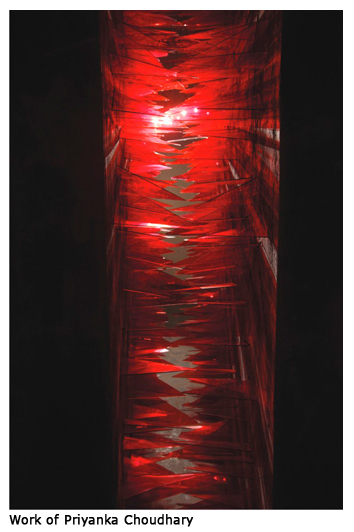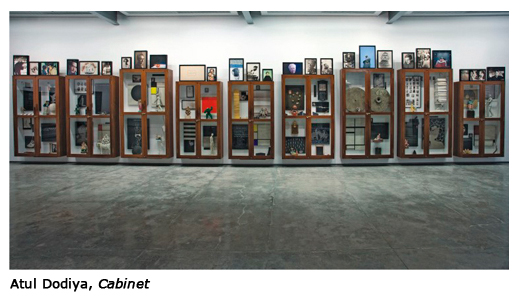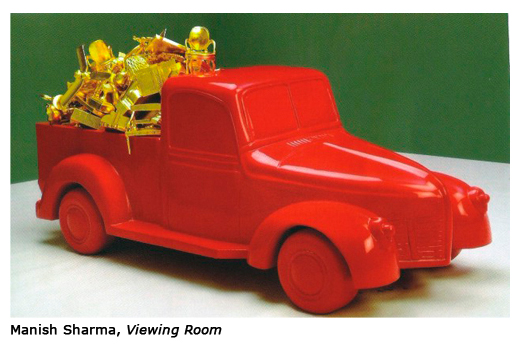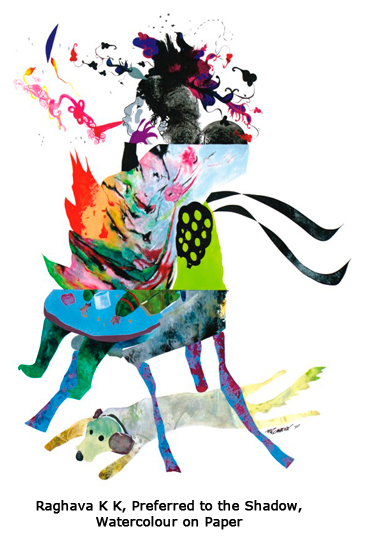- Publisher's Note
- Editorial
- In Conversation with Kanishka Raja
- Definitional Lack in an Inclusive World: Cutting Edge as Responsible Art
- Democratization Through Cutting Edge Art
- Mumbai for Cutting Edge
- Moments in Time (And a Little While After)
- In Transition
- Tip of Our Times
- Srishti School of Art, Design and Technology – A Cradle for Creative Excellence
- Cutting the Edges of Architecture
- Overview Cutting Edge
- The Matter Within: New Contemporary Art of India Featuring Photography, Sculpture and Video
- Generation in Transition: New Art from India
- Indian Master Painters at India Art Festival
- Life, Luxury & the Avant-Garde
- Mother India: The Goddess in Indian Painting
- The Last Harvest: Paintings of Rabindranath Tagore
- Asia Society Museum Presents Exhibition of Rabindranath Tagore's Paintings and Drawings
- Stieglitz and his Artists: Matisse to O'Keeffee
- Beauty of Unguarded Moments
- Across Times, Across Borders: A Report on the Chinese Art Exhibition
- A Summer in Paris
- Random Strokes
- The Emperor’s New Clothes and What It Really Means
- Understanding Versus Adulation
- What Happened and What’s Forthcoming
- Occupy Wall Street, The New Economic Depression And Populist Art
- Unconventional with Witty Undertones
- Narratives of Common Life and Allegorical Tales In Traditional and Modern Forms the Best of Kalighat 'Pats'
- Colours of the Desert
- Unbound
- I Am Here, An Exhibition of Video Self Portraits at Jaaga
- Staging Selves: Power, Performativity & Portraiture
- Venice Biennale Outreach Programme A Circle of Making I and II
- Cartography of Narratives, Contemplations on Time
- Joseph Kosuth: The Mind's Image of Itself #3' A Play of Architecture and the Mind
- Maharaja: Reminiscing the Glorious Past
- Art from Thirteen Asian Nations
- Tibetan Arms and Armor at Metrpolitan Museum of Art
- The Art of Poster Advertisement
- Unusual Angles and Facets of Museum Buildings
- Elegant Fantasies
- Art Collection and Initiatives
- Art Events Kolkata
- Mumbai Art Sighting
- Art Bengaluru
- Musings from Chennai
- Preview
- In the News
ART news & views
Mumbai Art Sighting
Volume: 4 Issue No: 22 Month: 11 Year: 2011
The Month that was
by Jasmine Shah Varma
Sharp edged art
These days one rarely comes across large scale installations and room-filling works that evoke an instinctual response from the viewer. A hand-out is necessary to understand the physical mass before us. Not so in the case of Delhi based Priyanka Choudhary's second solo exhibition Tetanus Midas that opened at Gallery Maskara on September 29th.
 The four works in the show were impactful on various counts; the concept, the technique, sense of material, judgement of scale, presentation and the psychological drama they evoked created an experience that wouldn't be forgotten shortly. The most powerful of the works was the site specific Don't Make Me Yell made of two 12 feet concrete walls erected next to each other with a narrow space between them. Within that space sharp red tinted glass shards were installed from top to bottom and across. The gallery lights further enhanced the work and led to a by-product an eerie shadow of the crisscrossing shards on the wall. The polarities, concrete versus fragile glass, fragile glass versus threatening sharp edges, and the grey stolid walls against transparent bloody glass evoked an essence of what the state of dilemma is like.
The four works in the show were impactful on various counts; the concept, the technique, sense of material, judgement of scale, presentation and the psychological drama they evoked created an experience that wouldn't be forgotten shortly. The most powerful of the works was the site specific Don't Make Me Yell made of two 12 feet concrete walls erected next to each other with a narrow space between them. Within that space sharp red tinted glass shards were installed from top to bottom and across. The gallery lights further enhanced the work and led to a by-product an eerie shadow of the crisscrossing shards on the wall. The polarities, concrete versus fragile glass, fragile glass versus threatening sharp edges, and the grey stolid walls against transparent bloody glass evoked an essence of what the state of dilemma is like.
In the other works Choudhary created a metaphor out of the phenomenon of rust and acid eating away at metal to explore humankind's everyday but cancerous anxieties, psychological violence and regrets that gnaw one's peace of mind. Tetanus Midas reaches out to the deep fears and dreadfulness of disintegration of life with empathy. Choudhary showed us another dimension to cutting edge art.
Tetanus Midas concludes on November 18.
Drawing the line
If you want to know how an artist thinks and plots his art, you must see his sketch book. Drawings are the bare bones or the scaffolding on which works of art are constructed. The Art of Drawing curated by Sudhir Patwardhan was a look at drawings by 10 artists held at The Guild Art Gallery between October 7 and 15. This exhibition was also hosted at Pune's Sudarshan Art Gallery.
 Drawings are intimate creations, usually preparatory but often they are ends in themselves. Gieve Patel explored the experience of looking at ever-changing vista of clouds in his abstract line drawings. Patwardhan's drawings for this show were the result of an exercise where photographs of various locations in a city were shot and then made into pencil drawings. The complex differences in documenting a place via photography as against drawing were on the artist's mind. Vilas Shinde's abstract drawings inspired by nature were made of hundred and thousands of lines, creating density, force and movement. Also in the show were compelling works by Himmat Shah, Krishen Khanna, K G Subramanyan, Tushar Joag, Dilip Ranade, Parag Tandel and Jyothi Base.
Drawings are intimate creations, usually preparatory but often they are ends in themselves. Gieve Patel explored the experience of looking at ever-changing vista of clouds in his abstract line drawings. Patwardhan's drawings for this show were the result of an exercise where photographs of various locations in a city were shot and then made into pencil drawings. The complex differences in documenting a place via photography as against drawing were on the artist's mind. Vilas Shinde's abstract drawings inspired by nature were made of hundred and thousands of lines, creating density, force and movement. Also in the show were compelling works by Himmat Shah, Krishen Khanna, K G Subramanyan, Tushar Joag, Dilip Ranade, Parag Tandel and Jyothi Base.
Classroom fantasy
On entering Chemould Prescott Road to see Atul Dodiya's solo show Bako exists. Imagine it felt like going back to schoolrooms with blackboards and roman numbers on top of each board indicating grades from I to XII. Each work in canvas, mounted on a wooden stand, was painted with oil, acrylic, watercolour, oil bar and marble dust. Excerpts from the English translation of Gujarati poet Labhshanker Thaker's text was handwritten by Dodiya. The viewing experience involved reading this text as it formed the crux of the compositions alongside the skeletal human figures, drawings of flora and shadowed imagery. The text, a fantastical dialogue between Bako and Mahatma Gandhi, set the mood for the dreamy contemplation of a young boy. It also posed questions regarding the practice of making art. In his walkthrough address Dodiya said he was interested in conceptual problems like why did chose to write the text in English and not the original Gujarati version, or should the viewer read the text at all or not. It was intriguing to see the different tone he employed to use the motif of Gandhi in this set of works vis a vis his earlier works. The artist's choice of handwriting the text rather than using stencils in order to give the semblance of impermanence, since blackboard text can be erased with a duster, gives further nuance to the transient nature of the scenes.
 Even as one appreciates the technical finesse and the concept of capturing a fictional dialogue in a dream, the experience of viewing and reading becomes tedious at some point. One wonders at the repetition of the idiom and the act of reading rather than viewing and absorbing imagery.
Even as one appreciates the technical finesse and the concept of capturing a fictional dialogue in a dream, the experience of viewing and reading becomes tedious at some point. One wonders at the repetition of the idiom and the act of reading rather than viewing and absorbing imagery.

The cabinet series Meditation (with open eyes) was a visually compelling work even if inconclusively puzzling without the artist's helpful explanation. The wooden cabinets with glass doors, the type found in schools, were packed with sundry objects, photographs, drawings and paintings. Seeing the mélange of objects in the showcases one is reminded of quizzes where one has to state the connection between seemingly unrelated images of events or personalities. The images of renowned people, film stills, reproduction of paintings by Piet Mondrian, souvenirs from museums with images of famous artworks, measuring containers, kitchen implements and books are packed within. This set had autobiographical glimpses into Dodiya's childhood interests, inspiration, preoccupation and elements that he grew up with leading to the person, artist and thinker that he is today. Bako exists. Imagine concluded on October 20.
Among other shows
 Bengaluru born Raghava KK who now lives in New York held his solo show at Art Musings. Titled Exquisite Cadaver the exhibition showcased his latest paintings on canvas and paper. Since he moved with his family to New York in 2007 Raghava's works have been inspired by the shift which has lead to questions of identity. He views himself and his life through the eyes of being a son, father, husband, student, teacher, Indian, NRI, artist among other titles. The works in this show have resulted from a game of exquisite cadaver he played with himself. He painted sections of the composition in various works at one go. Then he covered the painted portions to continue the remaining parts blindly without knowing exactly what was painted under the covered portion. The result is a pastiche of brightly coloured bizarre imagery that nonetheless blends together into a complete painting. The clever titles of the paintings further lend the viewer a reading into the paintings. The show concludes on November 30.
Bengaluru born Raghava KK who now lives in New York held his solo show at Art Musings. Titled Exquisite Cadaver the exhibition showcased his latest paintings on canvas and paper. Since he moved with his family to New York in 2007 Raghava's works have been inspired by the shift which has lead to questions of identity. He views himself and his life through the eyes of being a son, father, husband, student, teacher, Indian, NRI, artist among other titles. The works in this show have resulted from a game of exquisite cadaver he played with himself. He painted sections of the composition in various works at one go. Then he covered the painted portions to continue the remaining parts blindly without knowing exactly what was painted under the covered portion. The result is a pastiche of brightly coloured bizarre imagery that nonetheless blends together into a complete painting. The clever titles of the paintings further lend the viewer a reading into the paintings. The show concludes on November 30.
The National Gallery of Modern Art, Mumbai exhibited the sculptures of Carmel Berkson. The New York born artist has been based in India since 1977 and now her works have been acquired for the NGMA's permanent collection. Berkson's bronze sculptures are a contemporary study and an exploration of Indian myths and the aesthetics of ancient sculptures and murals in caves and temples. Her rendition of the mythical characters and stories is a result of her years of scholarly research and documentation of the systems of ancient Indian aesthetics. The exhibition concluded on November 6.
Shine on
 Fibreglass is a medium that has the potential to take on any shape and texture in the making of sculpture. And yet when one saw Skin Deep, the Art of Fibreglass at The Viewing Room it came across as a medium that is largely used to achieve an immaculately polished, glossy and smooth surfaced art object. Curated by Johnny ML it featured the works of Arunkumar HG, Chintan Upadhyay, George K, Gopinath S, G R Iranna, Manish Sharma, Rajesh Sagara, Subodh Kerkar among others. Quintessentially the medium of fiberglass is said to lack the textural qualities of metals, stone and wood. And this show did not dispel that observation. However some of the works did display trendiness. Manish Sharma's The Loot displayed his preoccupation with “rampant vandalism on the fabric of the city (Bikaner)”. Rajesh Sagara's larger than life pink coloured chick was a comment on genetically modified products and artificial breeding. Arunkumar HG's red coloured 'three monkey' motif was supposed to disturb the viewer and provoke him into thinking about the Gandhian emblem.
Fibreglass is a medium that has the potential to take on any shape and texture in the making of sculpture. And yet when one saw Skin Deep, the Art of Fibreglass at The Viewing Room it came across as a medium that is largely used to achieve an immaculately polished, glossy and smooth surfaced art object. Curated by Johnny ML it featured the works of Arunkumar HG, Chintan Upadhyay, George K, Gopinath S, G R Iranna, Manish Sharma, Rajesh Sagara, Subodh Kerkar among others. Quintessentially the medium of fiberglass is said to lack the textural qualities of metals, stone and wood. And this show did not dispel that observation. However some of the works did display trendiness. Manish Sharma's The Loot displayed his preoccupation with “rampant vandalism on the fabric of the city (Bikaner)”. Rajesh Sagara's larger than life pink coloured chick was a comment on genetically modified products and artificial breeding. Arunkumar HG's red coloured 'three monkey' motif was supposed to disturb the viewer and provoke him into thinking about the Gandhian emblem.
The bubblegum colours and factory finish of most of the sculptures in this show evoked a playful spectacle even though the artists aimed to discuss issues that disturbed them.
Skin Deep, The Art of Fibreglass concludes on November 19.